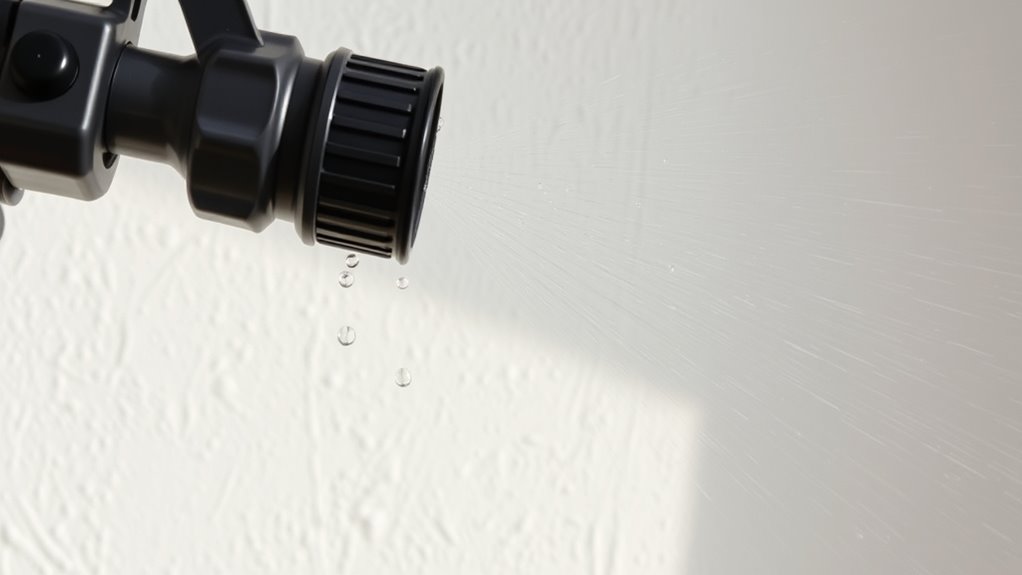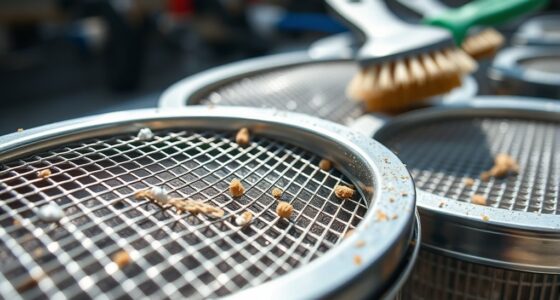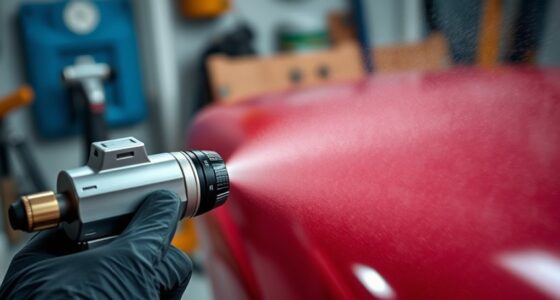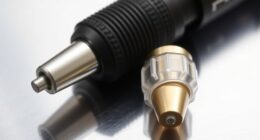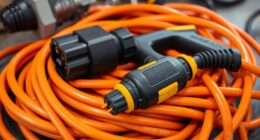If your airless sprayer leaves lines or streaks, start by checking your pressure—too low or too high can cause uneven spray. Make sure you’re using the right nozzle and tip, and keep them clean to prevent clogs. Properly thin your paint and prepare the surface beforehand. Also, practice steady, overlapping strokes, and regularly maintain your sprayer. Following these tips can help achieve a smooth finish; more details await you for perfect results.
Key Takeaways
- Ensure the spray pressure matches manufacturer specifications to maintain a consistent, even spray pattern.
- Check and replace worn or incompatible nozzles and tips to prevent uneven lines and streaks.
- Properly thin and mix paint according to recommendations for smooth, clog-free application.
- Regularly clean and maintain the sprayer, including filters and nozzles, to avoid clogs and uneven spray.
- Use steady, overlapping strokes at a consistent distance for even coverage and to minimize streaking.
Checking and Adjusting Spray Pressure

Before making any adjustments, you should check your airless sprayer’s pressure to ascertain it’s set correctly. Proper pressure helps control paint viscosity and ensures a smooth spray pattern. If the pressure is too low, the paint may come out unevenly, causing streaks and inconsistent spray consistency. Conversely, too high pressure can cause overspray and drips. Adjust the pressure according to the manufacturer’s specifications, often found on the paint or equipment manual. Keep in mind that paint viscosity affects how much pressure you need—the thicker the paint, the more pressure may be required. Regularly check and fine-tune your pressure settings during your project to maintain a steady, even spray, which prevents lines and streaks and results in a professional finish. Being mindful of common pitfalls can help you avoid other issues that affect the quality of your painting project.
Ensuring Proper Nozzle and Tip Selection
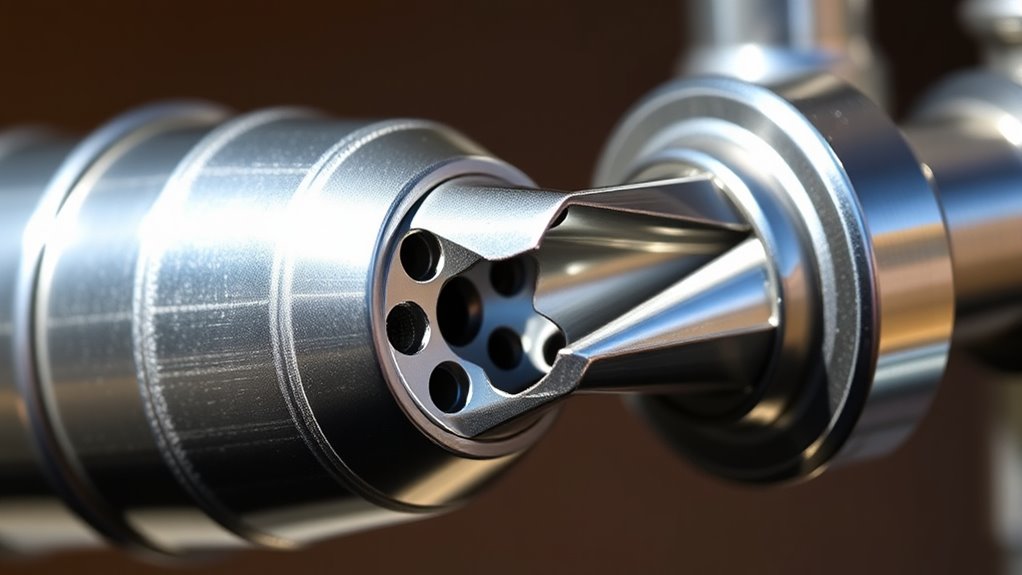
Choosing the right nozzle and tip is key to achieving a smooth, even spray pattern. If your nozzle has significant wear, it can cause uneven spray lines or streaks. Regularly inspect for nozzle wear and replace worn parts to maintain consistent spray quality. Similarly, selecting the correct tip size for your project ensures proper coverage without over- or under-spraying. Using an incompatible tip can lead to tip clogging, which disrupts the flow and causes streaks. Keep tips clean and free of debris to prevent clogging, and avoid using damaged or worn tips. Proper nozzle and tip selection, along with regular maintenance, helps you achieve a professional finish and prevents issues like lines or streaks caused by inconsistent spray patterns. Additionally, understanding spray pattern and how it relates to nozzle and tip choice can greatly improve your results.
Preparing and Thinning Your Paint Correctly
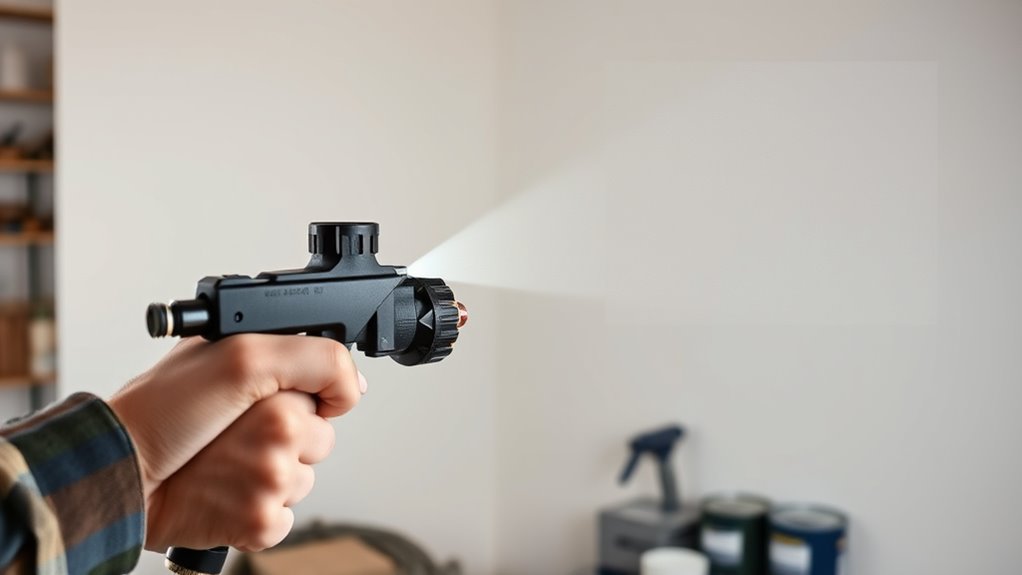
Properly preparing and thinning your paint guarantees a smooth, even spray and helps prevent lines or streaks. Achieving the right paint consistency is essential—you want it to flow smoothly without being too thick or too runny. To get this, start by mixing your paint thoroughly and gradually add thinning agents, like water or a paint conditioner, as needed. Always check the manufacturer’s recommendations for thinning ratios. Surface preparation is also critical; ensure the surface is clean, dry, and free of debris. Proper surface prep allows the paint to adhere evenly, reducing the risk of streaks. Additionally, understanding how sound vibrations can influence cellular regeneration and overall health highlights the importance of environment and technique in achieving a flawless finish. By combining correct thinning techniques with good surface preparation, you’ll achieve a professional-looking finish with minimal lines or streaks.
Maintaining and Cleaning Your Sprayer Regularly

Regularly maintaining and cleaning your airless sprayer keeps it functioning at peak performance and prevents issues like lines or streaks. Proper care extends the lifespan of your equipment and ensures consistent results. After each use, thoroughly flush the system to prevent paint buildup. Store your sprayer in a dry, protected area, and follow storage tips to avoid damage. Check component compatibility before replacing parts to ensure proper fit and function. Regularly inspect and clean filters, nozzles, and hoses to prevent clogs. Keep small parts organized and replace worn components promptly. Maintaining your sprayer not only improves performance but also reduces the likelihood of streaks caused by dirty or incompatible parts, giving you a smoother, more even finish every time. Additionally, consulting manufacturer-specific air purifier maintenance dos and don’ts can help ensure your equipment remains in optimal condition.
Applying Technique and Movement for Even Coats

To achieve a smooth, even coat with your airless sprayer, it’s essential to master your applying technique and movement. Keep your brush techniques controlled, using steady, overlapping strokes to prevent streaks. Maintain consistent paint consistency; if your paint is too thick or too thin, it can cause uneven coverage. When spraying, keep the sprayer at a steady distance from the surface, usually 12-14 inches, and move smoothly in parallel strokes. Avoid pressing too hard or stopping mid-spray, which can lead to lines. Practice your motion to develop a uniform speed and overlap each pass by about 50%. Proper technique minimizes streaks and ensures an even, professional finish. Additionally, understanding somatic awareness can help you develop better control and steadiness during application, reducing the chances of streaks.
Frequently Asked Questions
How Do I Identify if My Sprayer Is Malfunctioning?
To identify if your sprayer’s malfunctioning, start with sprayer diagnostics by checking for unusual noises or inconsistent spray patterns. Look for malfunction indicators like uneven paint flow, clogs, or pressure drops. If your sprayer struggles to maintain steady pressure or produces spurts instead of a smooth spray, it’s a sign something’s wrong. Regularly inspecting these signs helps you catch issues early and guarantees ideal performance.
Can Environmental Factors Cause Streaks in Spray Patterns?
Environmental influences can definitely cause streaks in your spray pattern, turning a smooth flow into a choppy river. Wind, humidity, and temperature fluctuations affect spray pattern consistency, making your finish look uneven. Wind can blow paint off course, while high humidity or extreme temperatures can cause paint to dry too quickly or unevenly. To keep a steady flow, spray in calm, moderate conditions and avoid extreme weather.
What Safety Precautions Should I Take When Troubleshooting?
When troubleshooting your airless sprayer, always prioritize safety. Wear protective gear like goggles, gloves, and a mask to prevent exposure to paint fumes and splatters. Be aware of hazards such as high-pressure sprays and electrical components. Turn off the sprayer and unplug it before inspecting or cleaning parts. Keep the work area well-ventilated and clear of obstructions to minimize accidents, ensuring a safe and effective troubleshooting process.
Are There Specific Paint Formulations Better for Airless Sprayers?
You might find it surprising, but choosing the right paint formulation makes all the difference for your airless sprayer. Opt for paints labeled as compatible with sprayers, ensuring better paint compatibility and smoother application. Regular sprayer cleaning prevents clogs and streaks, so always clean your equipment thoroughly after use. Using the correct paint consistency and formulation helps reduce streaks and extends your sprayer’s life, making your projects easier and more professional-looking.
How Often Should I Schedule Professional Maintenance for My Sprayer?
You should schedule a professional inspection and maintenance every one to two years, depending on usage. Regular maintenance helps prevent issues like streaks or lines caused by wear or buildup. If you use your sprayer heavily or for commercial projects, consider more frequent check-ups. Following a consistent maintenance schedule keeps your sprayer in top shape, ensuring smooth, streak-free application and prolonging its lifespan.
Conclusion
With a little patience and attention, you can turn your sprayer into a gentle breeze that caresses your surfaces, leaving behind a smooth, even finish. Think of each adjustment as tuning a delicate instrument, ensuring your strokes flow seamlessly like a calming stream. When you care for your sprayer and master your technique, you’ll paint a masterpiece with effortless grace—transforming streaks into a whisper of perfection that enhances every space.
